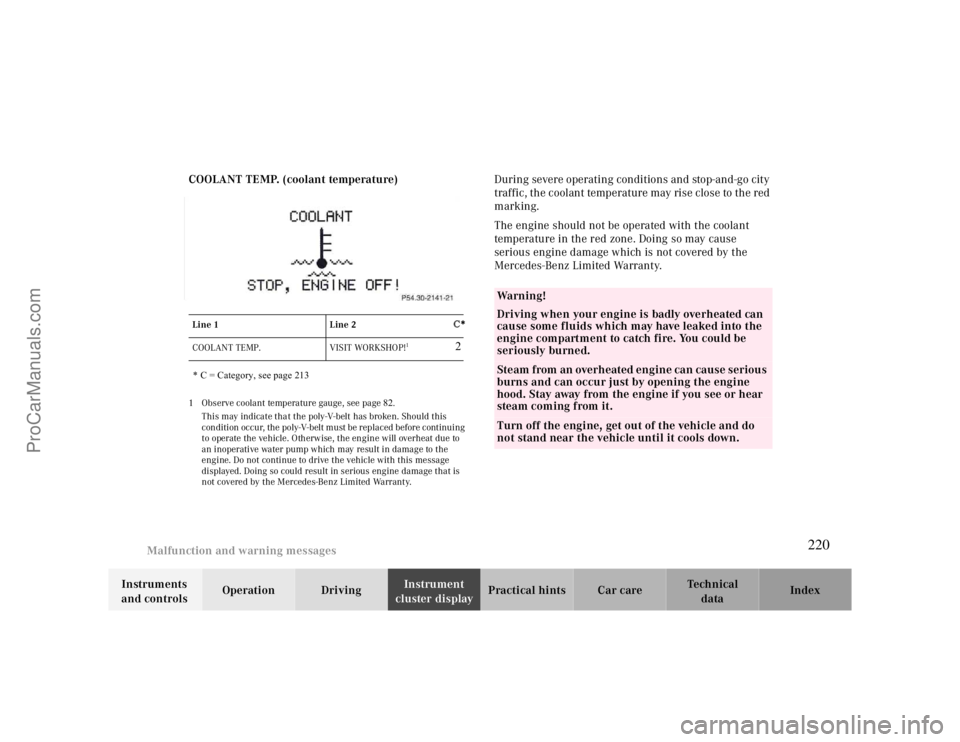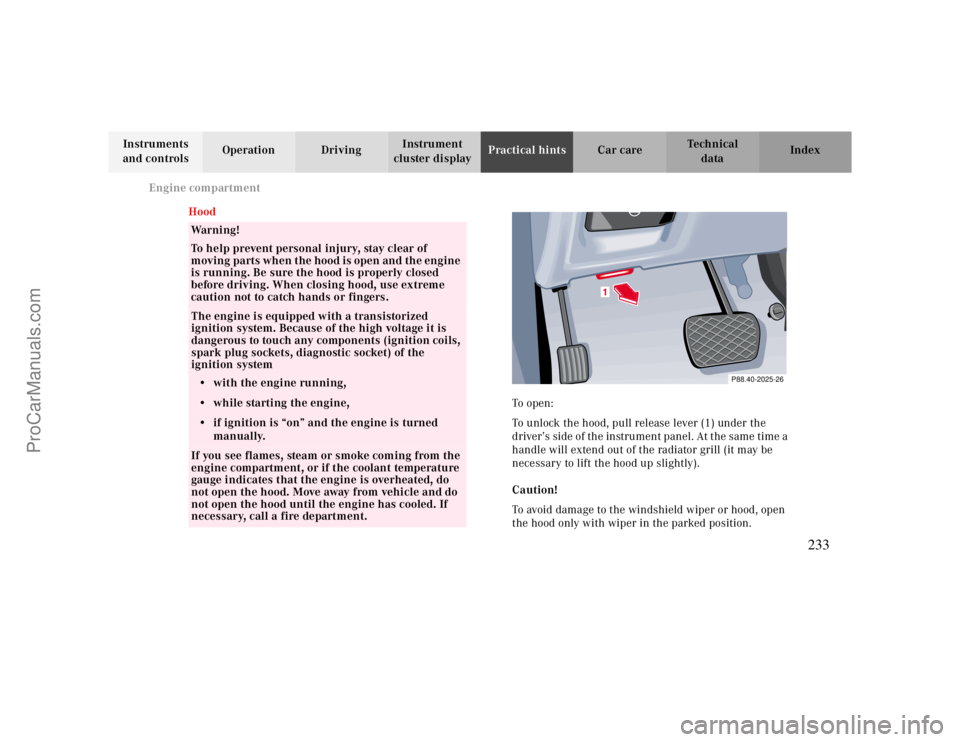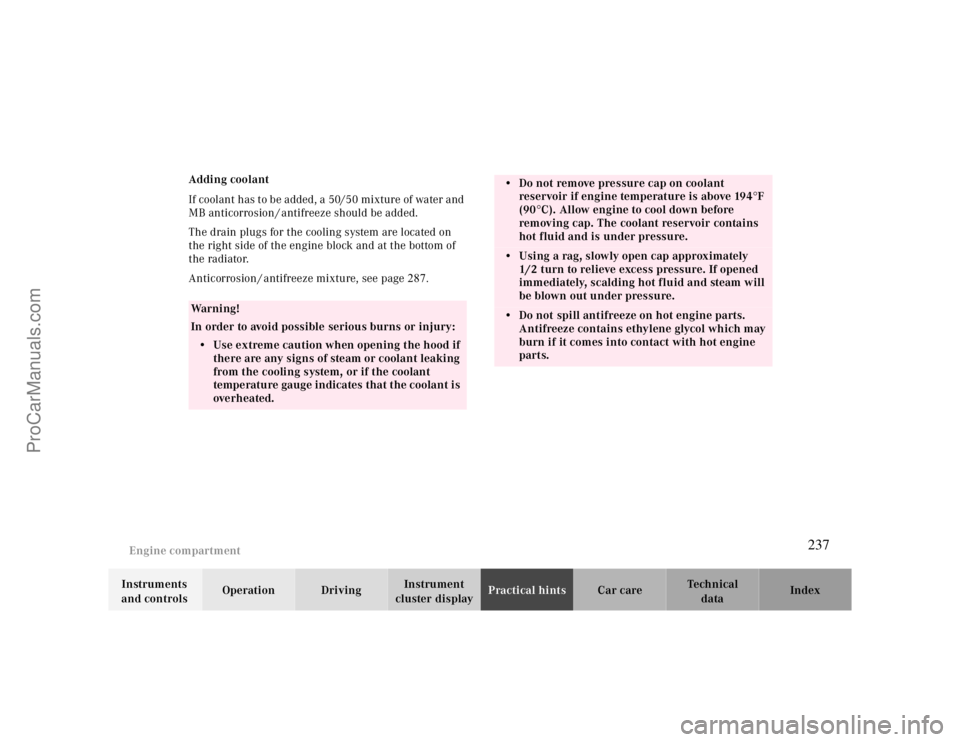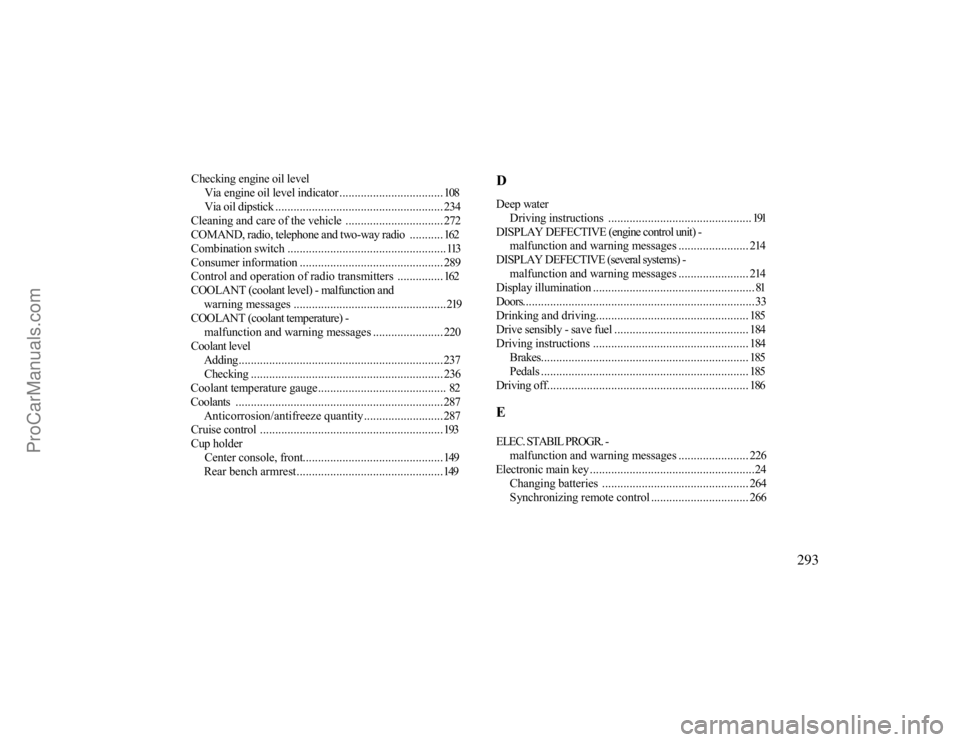2000 MERCEDES-BENZ CLK-CLASS coolant temperature
[x] Cancel search: coolant temperaturePage 220 of 299

Malfunction and warning messages
Te ch n ica l
data Instruments
and controlsOperation DrivingInstrument
cluster displayPractical hints Car care Index COOLANT TEMP. (coolant temperature)
1 Observe coolant temperature gauge, see page 82.
This may indicate that the poly-V-belt has broken. Should this
condition occur, the poly-V-belt must be replaced before continuing
to operate the vehicle. Otherwise, the engine will overheat due to
an inoperative water pump which may result in damage to the
engine. Do not continue to drive the vehicle with this message
displayed. Doing so could result in serious engine damage that is
not covered by the Mercedes-Benz Limited Warranty.
During severe operating conditions and stop-and-go city
traffic, the coolant temperature may rise close to the red
marking.
The engine should not be operated with the coolant
temperature in the red zone. Doing so may cause
serious engine damage which is not covered by the
Mercedes-Benz Limited Warranty.
Line 1 Line 2
COOLANT TEMP. VISIT WORKSHOP!
1
Wa r n i n g !
Driving when your engine is badly overheated can
cause some fluids which may have leaked into the
engine compartment to catch fire. You could be
seriously burned.Steam from an overheated engine can cause serious
burns and can occur just by opening the engine
hood. Stay away from the engine if you see or hear
steam coming from it.Turn off the engine, get out of the vehicle and do
not stand near the vehicle until it cools down. 2
C*
* C = Category, see page 213
220
ProCarManuals.com
Page 233 of 299

Engine compartment
Te ch n ica l
data Instruments
and controlsOperation DrivingInstrument
cluster displayPractical hintsCar care Index
Hood
Warning!
To help prevent personal injury, stay clear of
moving parts when the hood is open and the engine
is running. Be sure the hood is properly closed
before driving. When closing hood, use extreme
caution not to catch hands or fingers.The engine is equipped with a transistorized
ignition system. Because of the high voltage it is
dangerous to touch any components (ignition coils,
spark plug sockets, diagnostic socket) of the
ignition system
• with the engine running,
• while starting the engine,
• if ignition is “on” and the engine is turned
manually.If you see flames, steam or smoke coming from the
engine compartment, or if the coolant temperature
gauge indicates that the engine is overheated, do
not open the hood. Move away from vehicle and do
not open the hood until the engine has cooled. If
necessary, call a fire department.To o pen :
To unlock the hood, pull release lever (1) under the
driver’s side of the instrument panel. At the same time a
handle will extend out of the radiator grill (it may be
necessary to lift the hood up slightly).
Caution!
To avoid damage to the windshield wiper or hood, open
the hood only with wiper in the parked position.
P88.40-2025-26
1
233
ProCarManuals.com
Page 237 of 299

Engine compartment
Te ch n ica l
data Instruments
and controlsOperation DrivingInstrument
cluster displayPractical hintsCar care Index Adding coolant
If coolant has to be added, a 50/50 mixture of water and
MB anticorrosion / antifreeze should be added.
The drain plugs for the cooling system are located on
the right side of the engine block and at the bottom of
the radiator.
Anticorrosion / antifreeze mixture, see page287.
Warning!
In order to avoid possible serious burns or injury:
• Use extreme caution when opening the hood if
there are any signs of steam or coolant leaking
from the cooling system, or if the coolant
temperature gauge indicates that the coolant is
overheated.
• Do not remove pressure cap on coolant
reservoir if engine temperature is above 194°F
(90°C). Allow engine to cool down before
removing cap. The coolant reservoir contains
hot fluid and is under pressure.• Using a rag, slowly open cap approximately
1/2 turn to relieve excess pressure. If opened
immediately, scalding hot fluid and steam will
be blown out under pressure.• Do not spill antifreeze on hot engine parts.
Antifreeze contains ethylene glycol which may
burn if it comes into contact with hot engine
parts.
237
ProCarManuals.com
Page 284 of 299

Fuels, coolants, lubricants etc. - capacities
Te ch n ica l
data Instruments
and controlsOperation DrivingInstrument
cluster displayPractical hints Car care Index
Fuels, coolants, lubricants etc. – capacities
Vehicle components and their respective lubricants must match. Therefore use only brands tested and recommended
by us. Please refer to the Factory Approved Service Products pamphlet, or inquire at your Mercedes-Benz Center.
Capacity Fuels, coolants, lubricants etc.
Engine with oil filter 8.5 US qt (8.0 l) Recommended engine oils
Automatic transmission9.6US qt (9.1l) Automatic transmission fluid
Rear axle 1.4 US qt (1.3 l) Hypoid gear oil SAE 90, 85 W 90
Power steering
Accelerator control linkage Hydraulic fluidapprox. 1.1 US qt (1.0 l) MB Power steering fluid
Front wheel hubs approx. 2.1 oz (60 g) each High temperature roller bearing grease
Brake system approx. 0.5 US qt (0.5 l) MB Brake fluid (DOT 4)
Windshield/headlamp
washer systemapprox. 7.4 US qt (7.0 l) MB Windshield washer concentrate “S” 1
Cooling system approx. 11.7 US qt (11.1 l) MB Anticorrosion/antifreeze
Fuel tank including
a reserve ofapprox. 16.4 US gal (62.0 l)
approx. 2.1 US gal (8.0 l)Premium unleaded gasoline:
Posted Octane 91 (Avg. of 96 RON/86 MON)
Air conditioner system R-134a refrigerant and special PAC lubricant (Never R-12)1 Use MB Windshield Washer Concentrate “S” and water for temperatures above freezing or MB Windshield Washer Concentrate “S” and
commercially available premixed windshield washer solvent/antifreeze for temperatures below freezing. Follow suggested mixing ratios, see
Windshield/headlamp washer system on page238.
284
ProCarManuals.com
Page 288 of 299

Fuels, coolants, lubricants etc.
Te ch n ica l
data Instruments
and controlsOperation DrivingInstrument
cluster displayPractical hints Car care Index
the engine temperature will increase due to the lower
heat transfer capability of the solution. Therefore, do not
use more than this amount of anticorrosion/antifreeze.
If the coolant level is low, water and MB anticorrosion/
antifreeze should be used to bring it up to the proper
level (have cooling system checked for signs of leakage).
The water in the cooling system must meet minimum
requirements, which are usually satisfied by normal
drinking water. If your are not sure about the water
quality, consult your authorized Mercedes-Benz Center.
Anticorrosion/antifreeze
Your vehicle contains a number of aluminum parts. The
use of alum inum components in m otor vehicle engines
necessitates that anticorrosion/antifreeze coolant used
in such engines be specifically formulated to protect the
aluminum parts. (Failure to use such anticorrosion/
antifreeze coolant will result in a significantly
shortened service life.)Therefore the following product is strongly
recommended for use in your vehicle: Mercedes-Benz
Anticorrosion/antifreeze agent.
Before the start of the winter season (or once a year in
the hot southern regions), you should have the
anticorrosion/antifreeze concentration checked. The
coolant is also regularly checked each time you bring
your vehicle to your authorized Mercedes-Benz Center
for service.
Anticorrosion/antifreeze quantity
Approx. freeze protection
– 35°F
(– 37°C)– 49°F
(– 45°C)
5.9 US qt
(5.6l)6.5US qt
(6.1 l)
288
ProCarManuals.com
Page 293 of 299

Checking engine oil level
Via engine oil level indicator.................................. 108Via oil dipstick ....................................................... 234
Cleaning and care of the vehicle ................................ 272COMAND, radio, telephone and two-way radio........... 162Combination switch ....................................................113Consumer information ............................................... 289Control and operation of radio transmitters ............... 162COOLANT (coolant level) - malfunction and
warning messages ..................................................219
COOLANT (coolant temperature) -
malfunction and warning messages ....................... 220
Coolant level
Adding...................................................................237Checking ............................................................... 236
Coolant temperature gauge.......................................... 82Coolants ....................................................................287
Anticorrosion/antifreeze quantity..........................287
Cruise control ............................................................193Cup holder
Center console, front..............................................149Rear bench armrest................................................149
DDeep water
Driving instructions ............................................... 191
DISPLAY DEFECTIVE (engine control unit) -
malfunction and warning messages ....................... 214
DISPLAY DEFECTIVE (several systems) -
malfunction and warning messages ....................... 214
Display illumination ..................................................... 81Doors............................................................................33Drinking and driving.................................................. 185Drive sensibly - save fuel ............................................ 184Driving instructions ................................................... 184
Brakes.................................................................... 185Pedals .................................................................... 185
Driving off.................................................................. 186EELEC. STABIL PROGR. -
malfunction and warning messages ....................... 226
Electronic main key ......................................................24
Changing batteries ................................................ 264Synchronizing remote control ................................ 266
293
ProCarManuals.com